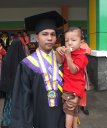Welcome to ICT-based Instructional Design
Lecturers

Leil Badrah Zaki S.Pd., M.Pd
NIDN: 1025108801
Email: leil@uib.ac.id
Universitas Internasional Batam

Riyadi Saputra S.Pd., M.Pd
NIDN: 1025108801
mail:riyadisaputra732@ymail.com
Universitas Dharmas Indonesia
Course Description:
This course is intended to develop knowledge of adult learning and hone
understanding of widely used instructional design models specifically for
teaching EFL. The program intends to equip the participants with skills to
design and analyze professional learning resources. The students will learn the
essentials of designing and developing measurable instructional programs
informed by fundamental learning theories to meet a variety of learner needs.
The participants will be able to design and develop online learning management
systems with the use of ICT. at the end of the course, the students are expected
to be able to apply the principles of instructional design following a step-by-step model from needs assessment to evaluation and build a solid understanding
of the process of a learning design.
Credit : 3 sks
Course Learning Outcomes:- CPMK 1 Students are able to identify the use of ICT applied in the development and practice of learning English and correlate it with educational principles and theories regarding approaches, strategies, methods, techniques, and learning models
- CPMK 2 Students are able to identify the concepts and theories of planning and managing ICT-based resources in the administration of classes, schools and educational institutions for which they are responsible, and evaluate their activities comprehensively.
- CPMK 3 Students are able to analyze the need for ICT in the scope of English language learning at every level of an educational unit in Indonesia.
- CPMK 4 Students are able to apply educational principles and theories regarding approaches, strategies, methods, techniques, and learning models in ICT-based learning media at every level of educational units in Indonesia
- CPMK 5 Students are able to design digital-based learning tools for online learning creatively, innovatively, and based on the results of needs analysis by applying logical, critical, systematic, and innovative thinking.
Assess your role and your opinion about your group discussin